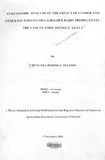| dc.contributor.author | Cheng'ole, JM | |
| dc.date.accessioned | 2013-05-08T08:13:45Z | |
| dc.date.available | 2013-05-08T08:13:45Z | |
| dc.date.issued | 2001-11 | |
| dc.identifier.citation | Cheng'ole, J.M.(2001).An economic analysis of the impact of gender and other factors on smallholder dairy productivity: the case of Embu District, Kenya) | en |
| dc.identifier.uri | http://erepository.uonbi.ac.ke:8080/xmlui/handle/123456789/20135 | |
| dc.description | Msc-Thesis | en |
| dc.description.abstract | The problem of diminishing dairy productivity and thus dairy production in the face of rising
population density is not unique to Kenya, but is an issue of concern for sub-Saharan Africa. Lack of
affordable good quality dairy feeds poses the greatest challenge to the efforts being made to raise dairy
productivity. Improved fodder plants dairy technology offers the best option as a substitute or
supplement to the expensive commercial dairy meals. In Kenya, efforts to develop and disseminate this
technology to smallholder dairy farmers have been on for over a decade. Although efforts to raise dairy
productivity are being done, it is not known how they impact on the farmers on the basis of their gender
because men and women farmers are faced with different opportunities and constraints.
This study investigated the effect of improved fodder plants and zero grazing dairy technologies on the
performance of male and female smallholder dairy farmers. The gender of the dairy farmers was
considered in order to analyse if there is performance variation due to the different circumstances male
and female farmers are exposed to in their farming activities. Three hundred and one smallholder dairy
farmers were interviewed in Manyatta and Runyenjes divisions of Embu District by use of a semistructured
questionnaire. The households were grouped into male-headed and female-headed. Within
each of the two household groups, there exist male-managed, female-managed or jointly managed dairy
enterprises. Categorization at the two levels was based on the preposition that female dairy managers
from male-headed households differ in resource endowment levels to those from female-headed
households and so do the male dairy enterprise managers. Statistical analysis helped in determining the
comparative objectives; The Cobb-Douglas production model was .estimated with a view of
determining the influence of the various socio-economic factors on dairy performance.
implying that many farmers had adopted the technology. Male farmers were realizing higher dairy
performance (dairy productivity of 8.90 litres per animal per day) than female farmers (7.00 litres per
animal per day), mainly because the latter, especially within female-headed households were on
average poorer than their male counterparts. Also, adopters of the improved technologies (dairy
productivity of 7.l9 litres per animal per day) achieved higher dairy performance than the non-adopters
(5.51 litres per animal per day). An assessment of male-managed and jointly managed dairy enterprises
showed that the improved fodder plants adopters posted higher dairy performance than their nonadopter
counterparts.
Availability of market for raw milk, access to commercial dairy feeds, control of the dairy benefits by
the dairy enterprise manager, education level of the female dairy enterprise manager and monthly
income were found to positively influence dairy performance.
Thev ariation in dairy performance between male and female farmers implies that efforts to enhance
dairy performance should consider the gender of the farmer with a view to ensure that all of them
benefit from the efforts. The importance of improved fodder plants in dairy was shown and therefore
efforts to ensure more of the farmers adopt the technology should be enhanced.
Encouraging the formation of dairy co-operatives to process and market milk for the farmers may
provide an avenue to try and alleviate the problem of unavailability of market for raw milk. Efforts to
develop and manufacture cheaper but safer and high quality dairy feeds should be instituted with a view
to meet the demands of the low-income smallholder dairy input market. | en |
| dc.description.sponsorship | University of Nairobi | en |
| dc.language.iso | en | en |
| dc.subject | Economic analysis | en |
| dc.subject | Gender | en |
| dc.subject | Smallholder Dairy Productivity | en |
| dc.subject | Embu District | en |
| dc.subject | Kenya | en |
| dc.title | An economic analysis of the impact of gender and other factors on smallholder dairy productivity: the case of Embu District, Kenya) | en |
| dc.type | Thesis | en |
| local.publisher | Department of Agricultural Economics, University of Nairobi, Kenya | en |

